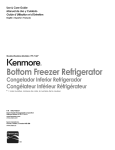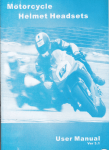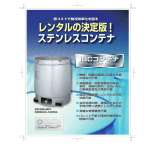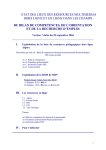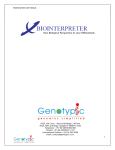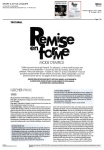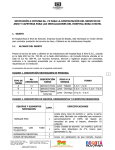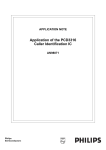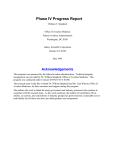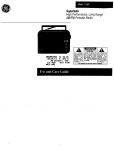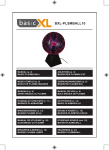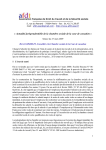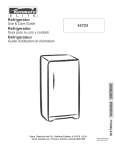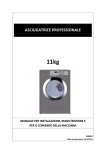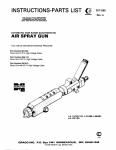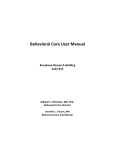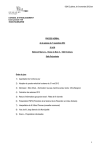Download 31295016578782
Transcript
DATA MANAGEMENT IN RECENT MAMMAL
COLLECTIONS
by
RAEGAN DEANNE KING, B.S.
A THESIS
IN
MUSEUM SCIENCE
Submitted to the Graduate Faculty
of Texas Tech University in
Partial Fulfillment of
the Requirements for
the Degree of
MASTER OF ARTS
Approved
Chairperson of the Committee
Accepted
4nterim Dean of the Graduate S^ogl^
December, 2000
© 2000 RAEGAN D. KING
ALL RIGHTS RESERVED
ACKNOWLEDGMENTS
I would like to express my sincere gratitude to the members of my thesis
committee: Dr. Robert J. Baker, Chair, Dr. R. Richard Monk, and Ms. Nicola Ladkin.
Completion of this thesis would have been impossible without their guidance and
support. I thank Dr. Baker for his undying devotion to science and mammalogy and for
his encouragement and motivation throughout my education at Texas Tech University. I
would also like to thank Dr. Monk for his innovative design and use of relational
databases and bar code technology in natural history collections; this thesis project is an
extension of his dissertation, specifically concerning field use of computers and the
impact such use has on collection management. I also thank Ms. Ladkin for her
willingness to lend a concerned ear, her words of encouragement, and her knowledge and
support concerning the use of computers in museums.
I would like to thank Dr. Robert D. Bradley, Dr. Ron A. Van Den Bussche, Dr.
Meredith J. Hamilton and the 1999 Mammalogy Field Methods class: Darin Carroll,
Melinda Clary, Cody Edwards, Kristina Halcomb, Michelle Haynie, Federico Hoflmann,
Steve Hoofer, Jordana Hooten, Bert Marks, Charlie Martin, Lisa Mitchell, Chris
O'Meilia, Mark O'Neill, and Eric Webb for making this project possible. I joined their
field crew to collect data as they continued a survey of the mammals of Texas. I was
able to use this valxiable field experience as the majority of my thesis project, hopefully
contributing to the goal of the Natural Science Research Laboratory to be among the
leading museum collections in developing and implementing progressive ideas and
procedures.
I also thank Ms. Amy Halter and Ms. Susan Fishman-Armstrong for their
assistance in processing and refining my research data (and the accompanying
specimens!) upon returnfromthe field methods excursion. Also, the support and
suggestions of Ms. Emma Dawson, Ms. Katie Anderson, Ms. Jacqueline Chavez, and Ms
Marcia Revelez were greatly appreciated. Thank you to Dr. Bradley, Dr. Clyde Jones,
and Ms. Brenda Rodgers for reviewing portions of this manuscript and making valuable
suggestions. Special recognition and thanks belong to Dr. Robert C. Dowler who ignitec
my interest in mammalogy and mammal collection management and encouraged me to
pursue a Master's degree in Museum SciencefromTexas Tech University.
Finally, I thank my parents, David and Beverly Fry, for the support, concern,
motivation, encouragement, patience, and love shown to me throughout my life and
especially during graduate school. Thanks to my brother, Aaron Fry, for reminding me of
the value of good writing and hard work. Ultimately, I would like to thank my husband,
Timothy King, for his patience and support during the development, research, and
writing of this thesis project. Knowing that I have such a devoted, intelligent, and strong
partner in life is the greatest comfort in the world.
Ill
TABLE OF CONTENTS
ACKNOWLEDGMENTS
i
ABSTRACT
>
LIST OF FIGURES
v
CHAPTER
L
INTRODUCTION
]
IL
MATERL\LS AND METHODS
5
Wildcat in
5
Materials
6
Methods
11
m.
RESULTS AND DISCUSSION
U
IV.
CONCLUSION
21
LITERATURE CITED
23
APPENDIX: ON-LINE USER'S MANUAL FOR WILDCAT HI
24
IV
ABSTRACT
Current trends in museum practices show increasing awareness of the importar
role complete and accurate data play in collection management. Careful integration of
computer technology into data management procedures can reduce the effort associated
with multiple transcriptions of data, increase the accuracy and consistency of data, and
result in a more useful electronic database. WildCat is a relational database managemer
system developed in 1997 to facilitate data management in the Recent mammal
collection of Texas Tech University. WildCat consists of four distinct parts, the third o1
which, WildCat III, is a data entry application for use in-house and in the field. WildCa
III allows a new approach to data management by introducing computerized data entry
into thefirststages of data gathering rather than at the more traditional final stage. This
thesis determines the effectiveness of WildCat III in the capture offield-generateddata,
provides information concerning the use of computers in field situations, and discusses
the impact electronic data capture has on mammal collections management.
LIST OF FIGURES
1.
Relational database design schematic illustrating the linking
of separate tables using key fields
2.
Completed field data ledger (TK, Tissue and Karyotype) sheet
3.
4.
Bar coded specimen tags, tissue tubes and tissue tube stickers
Bar code "Scan Stop" card
K
5.
Site data capture screenfromWildCat III
1'
VI
CHAPTER I
INTRODUCTION
The quality of data associated with specimens in systematic mammal collections
has long been a concern not only for researchers but also for museum professionals
responsible for maintaining such collections. In many museum collections where
research and exhibition are practiced, the data associated with a specimen quite often
determines the value of that specimen. According to Hall (1962), the data associated
with a specimen may be more valuable than the specimen itself Therefore, maintenance
of collection-related data is of utmost importance to ensure the perpetual value of
scientific specimens.
Traditionally in many mammal collections, the primary source of data for a
specimen is the specimen tag. Data tags are immediately visible thereby facilitating
collection organization and other management duties. However, data tags hold a limited
amount of information on a relatively small space. Maintenance of secondary data
sources, such as field notes, personal journals and preparation catalogs, collection
catalogs, inventory lists, accession cards, and loan records is imperative for collection
data to be complete and accurate. Historically, processing primary and secondary data
was accomplished using various hand-written methods. As collections grew, paper-base
data collections also grew but soon became redundant, disorganized, unmanageable, and
inaccessible. Data must remain accessible to remain valuable (Yates, 1987). To make
data management simpler and more effective, museum professionals turned to
technology.
In the past, various technological advances, such as tjqjewriters, were used to
enhance data handling, but computers soon became the tools of choice for curators,
collections managers, and museum registrars to aid in data management. Computers
have been used as collection management tools to varying degrees of success, and today,
electronic data management still offers particular advantages to users. In any museum
collection, not only mammal collections, computers should only be used for those jobs
which computers can complete better than humans, such as generating reports, searching
for particular data, or creating labels. Electronic databases can allow for the storage of
more data, greater access to data, and more efficient processing of data, but no computer
can do any specific task without being told to do so. Without proper programming, a
computer will not curate a collection, ensure data accuracy or completeness, or solve
collection management problems. Computer are best used as collection management
tools (McLaren et al., 1987).
The mammal collection database at the Natural Science Research Laboratory
(NSRL) of the Museum of Texas Tech University was updated in 1997froma flat
database model to a relational database model. The NSRL's flat database stored data fo
every specimen in the collection in a single table similar in structure to a spreadsheet.
Entering all the data for every specimen in a collection created a great deal of
redundancy where many of the specimen records contained identical data. Maintaining
data in aflatdatabase system consumes time for data entry, leads to a greater chance for
error as data are entered repeatedly, uses greater physical space on a computer hard
drive, and results in slower and limited searching and printing capabilities (Monk, 1997
To increase the efficiency of data handling, the NSRL moved to a relational
database model written in Microsoft® Visual FoxPro*. Relational databases reduce data
redundancy by storing related collection data in separate tables and linking those tables
via key fields (Fig. 1). By restructuring the flat NSRL database into linked tables like
collecting site data, specimen data, and inventory data, the physical size of the database
is reduced, a great deal of data redundancy is eliminated, and the data is much more
efficientiy accessed and retrieved (Monk, 1997).
C3 I
Database Designer
,
ML
•
I
silrs
^Fields:
noteref
sitenum
CSIndexes:
noteref
sitenum
fi
1 -v
\
jt
1-
pWf
^Fields:
sitenum
country
stale
county
locality
collector
^Fields:
sitenum
series
fieldnum
genus
speaes
colldate
sex
[indexes:
fsitenum
>
^
1
M.
^-^
.^Fields:
series
fieldnum
skin
skull
skeleton
alcohol
tissues
Gllndexes:
fieldnum
(indexes:
sitenum
^
colldate
^
genus
riiMs
gFields;
notes
colldate
L-
taocjfiom^
genus
family
order
noteref
dndexes;
t
,;
^Fields
\
?noteret
colldate
OIndexes
genus
.ZJ
1
T
•
•
T
*I.J
i*i
Figure 1. Relational database design schematic (partial) illustrating the
linking of separate tables using key fields (in bold typeface).
Although computers and relational databases do indeed offer great advantages to
data management, the placement of computer use in typical collection management
procedures can actually alter a computer's effectiveness. For example, entering data into
a computer at the end of a series of data handling steps will not save effort associated
with recording field and museum data by hand, deciphering non-standard data, and
transcribing that data into various ledgers and catalogs by hand. Ultimately, data entry at
the end of data handling only serves to record less complete and less accurate datafroma
great number of data sources. By introducing computerized data entry into the first
stages of the data gathering process, many labor-intensive and error-prone data handling
steps can be avoided, thus resulting in a more complete, accurate, and concise initial
database. Likewise, subsequent collection management tasks such as generating reports,
inventories, and catalog sheets will be made easier, less time-consuming, and more error
free.
CHAPTER II
MATERIALS AND METHODS
Wildcat III
Wildcat is a relational database management system developed in 1997 to
facilitate data management in the Recent mammal collection of Texas Tech University.
A relational database management system is a software program used to "create,
maintain, modify, and manipulate a relational database" (Hernandez, 1997, p. 17).
Wildcat consists of four distinct parts, the third of which, WildCat III, is a data entry
application for use by researchers in the field and museum staff members in-house.
Wildcat III allows a new approach to data management by introducing computerized
data entry into thefirststages of the data gathering process rather than in the more
traditional final stage. Computerized data capture early in the data gathering process
benefits general data management by reducing errors associated with transcription and bj
decreasing time attributed to maintaining a hand-written cataloging system. Relational
databases reduce data redundancy; i.e., a WildCat III user needs not repeatedly enter site
information for each specimenfromthe same locality. Site data are entered once in
Wildcat III and linked to each of many specimens that may have been collected and
processed from that site.
In the field, WildCat III will permit data capture on a laptop computer, thereby
creating an initial, relational, electronic database of all datafromfieldnotes, personal
preparation catalogs, specimen tags, and tissue tubes for every specimen resulting from a
given collecting trip. As designed, the use of WildCat III for data capture in the field ii
not "field cataloging" however. Upon return to the museum, the field-generated databj
is held in WildCat III until the electronic data are verified to be complete and accurate.
After verification, the field-generated database is downloaded into WildCat I importing
into the main database of the mammal collection. WildCat I is programmed to assign
unique catalog numbers to new specimen records thereby maintaining a sequential,
primary database which is available for search, distribution, and curation of the mammi
collection and frozen tissue collection (Monk, 1997).
Materials
Equipment and supplies used in the field are divided by importance in electronii
field data capture using WildCat III. Essential computer equipment includes the least
amount of hardware and software required to capture data using WildCat III in the field
Essential hard copy material includes hard copy data capture and data linking items. A
the discretion of the trip coordinator, the secondary equipment may or may not be the
responsibility of the computer operator. During the development of computerized field
data capture, the field data ledgers (TK books) have ftinctioned as an alternative data
source and as a backup copy of thefield-generateddata in case of loss of electronic cop
Additional equipment includes hardware and software to be used at the discretion and
need of the computer operator.
Essential computer equipment:
•
IBM laptop computer (with at least 16 megabytes of RAM) equipped wdth
Microsoft® Windows 95 (or newer version) and WildCat III,
•
Extra battery for powering computer,
•
AC adapter for charging computer/battery,
•
DC adapter for charging computer/battery,
•
Backup diskettes.
Essential hard copy material:
•
Field Data ledgers (called TK books in the Museum of Texas Tech
University) with uniquely numbered sheets (Fig. 2) designated for the trip,
•
Bar coded skin/skull/skeleton/alcohol tags (Fig. 3) vsdth corresponding
field ledger (TK) numbers,
•
Tissue tubes and bar coded tissue tube stickers (Fig. 3) with
corresponding field ledger (TK) numbers.
TKS.i7?ri
SPECIES
Country
State T^^XA:^
County UA^^i.c\L
Specific Locality CWAP^figA>i^ vo AUAA.
„____
,.™,™,.^ (Locality same as: TK
UTM or Lat/Lortg
>^ 4 ( * 6 Q S f l - 3>^S>\tolb
Elev^ation
Collector
BCAt^t iftTv F=r^t.
CoHoction Dato ZO O U L ^ H '
Preparator P'Ct ^c»P»vt^A
No/Skr
Pranaration Datft^tf SUL<^^
VOUCHER:
^ Skin
.Skull
Other
AlCOtlQltc
Cataloia Wumber
Museum Coileclion
Measurements
2^
^^^
Mal»
TISSUE:
_JL_Heart/Kklney
Heart
Kidnev
\
Ffimale
Muscle
eiocd
,^fmbryo
OTHER PREPARATIONS:
MiCottc
SDcrm
MISCELLAINEOUS:
Age:
JuvenUe
Molting:
Yes
Broken Tall;
Yes
Special Ntumbers
R«5pn<xJucliveCofiditiort
Lung
Spleen
'
•
. vt
*Hr
MM
t<llk>
^
— Post-cranial Skalaton
Melotic
Kapyoilyise
SutsaduH
No
No
-
=.
<r(iBM»
•«ni«
_,_,,____,__
__Rep«oduiCtive Organs
Entire Spedmen
IvSfS Buffer
Alcohol
Other
Tissue Culture
Other
AdvH
ACUC fsfumbef
Comments
Pfetfse M out form compietety. Hems m boM am mandalory fietds.
Figure 2: Completed field data ledger (TK, Tissue and Karyotype) sheet.
Figure 3: Bar coded specimen tags, tissue tubes and tissue tube stickers.
Additional equipment which may be usefiil:
Portable printer,
User's manuals for computer, Windows 95, and WildCat III,
Extra diskettes not for backup.
Extension cords for AC and DC adapters.
External mouse.
Bar code scanner.
Bar code ''scan stop " card (Fig. 4),
Cellular modem-PC card.
Cellular phone with extra battery.
Solar panel as optional power source.
Other software such as MS Office, etc.,
Carrying case to protect equipment from physical damage.
Figure 4: Bar code "Scan Stop" card.
10
Methods
A continuation of the initial field test of WildCat HI described in Automated Dati
Management in Systematics Collections (Monk, 1997) was performed July 8-24,1999, t(
capture data generated by Texas Tech University's Mammalogy Field Methods class led
by Dr. Robert D. Bradley. Prior to this project, the individual (Raegan King) assigned to
capture data electronically had no knowledge of either the program or general database
design and usage. The designated computer operator was introduced to WildCat and
learned to operate it in approximately 4 hours by following instructions contained in the
existing WildCat HI Data Entry User's Guide (Appendix D of Monk, 1997) and the
NSRL Mammal Collection Data Standards Guide (Appendix A of Monk, 1997). Before
use under field conditions, data capture for museum specimens was practiced in-house to
ensure that the hardware worked properly and that the individual capturing the data
understood the software. During the trip, the computer operator was responsible for
using WildCat III to capture, maintain, and edit site and specimen data. Writing data in
the field data ledgers and organizing bar coded specimen tags, labels, and tissue tubes
was not assigned to the computer operator of WildCat III but was assigned to other
members of the Field Methods class. After the trip, the computer operator verified all
data, checking for accuracy and completeness, prior to cataloging the field collection intc
the mammal collection. Cataloging was completed by downloading the field-generated
database into WildCat I and importing it into the main mammal collection database
where the next series of unique catalog numbers were assigned. The newly cataloged
data were immediately printed and stored with the hard copy mammal collection catalog
11
CHAPTER m
RESULTS AND DISCUSSION
A single WildCat III operator was able to capture data generated by the collecting
and specimen preparation activities of the 17 class participants for the duration of the
research trip. Upon return to the NSRL, the final computerized data set (excluding the
frozen tissue inventory) for 598 specimens was found to contain fewer than 38 total
errors or inconsistencies (including temporary species identifications). The 38 errors
constituted 0.42% of the total number of possible errors (15 data categories were
recorded for each of the 598 specimens). All errors were identified and corrected by
NSRL staff members. Types of errors included but were not limited to incorrect personal
preparation numbers, incorrect county names for localities, and incorrect Universal
Transverse Mercator (UTM) coordinates.
Incorrectly recorded personal preparation numbers were primarily the result of
mistakes in the individual record keeping of various students in the Field Methods class.
Incorrectly recorded county names resultedfrominaccuracies encountered in recording
and communicating field locales orfromconfiising, multi-county maps of particular
wildlife management areas. Incorrect UTM coordinates recorded in WildCat III occurred
during transcription of written field notes to the computer. Also, the normal field
procedure of many preparators processing animalsfrommultiple localities
simultaneously may have led to an increased error rate, requiring greater attention from
the computer operator. Finally, temporary species identifications were assigned in the
12
field to all specimens; therefore, erroneous species identifications recorded in the
computer database, in the TK books, and on specimen tags was not unusual. Species
identifications were verified or corrected at the NSRL when the collecting trip was
complete. In general, the same types of errors occurred in the data recorded in both the
TK books and the computer. The greaterfrequencyof errors in the TK books was
attributed to multiple individuals entering data into the ledgers by hand.
Mistakes in thefrozentissue inventory were not considered part of the previously
mentioned error rate, as "tissue inventory" was not included in the data categories printed
on the hard copy editing sheets used at the NSRL. The Field Methods tissues were
inventoried separately to resolve problems prior to their installation into the NSRL's vital
tissue collection. Tissue inventory error types included incorrectly recorded tissue types
(liver, heart, kidney, etc.), incorrectly recorded numbers of tissues for one animal, and
incorrectly recorded numbers of multiple tubes of one tissue sample. Erroneous tissue
data appeared in the TK books and the computerized database. The majority of errors in
the database can be attributed to the number of individuals reporting information at one
time and to the need to put tissues in the liquid nitrogen tanks before they begin to
degrade. These two factors restricted the computer operator's ability to use the bar code
scanner to inventory tissues during this field test. During this study, it was decided that
the computer operator would enter all of the tissue inventory data by hand to prevent
slowing the specimen processing by the 17 preparators. However, when the bar code
scanner is used in the field to expedite data entry, some data must still be entered by
hand. For example, if additional vials or tissue types are saved for which no bar coded
13
labels have been pre-printed (adrenal gland, for example) these data must be entered
manually. When multiple tubes of one tissue type are collected and only one label is bar
coded, the bar coded tube is scanned as many times as necessary to account for all the
extra tubes of a given sample, or the number of tubes may be typed manually.
While the computer software performed well, the computer hardware was more
problematic. Whenftillycharged, the laptop computer's lithium battery provided power
for only two hours of continuous use. The additional battery helped provide extended
power as it too lasted two hours, but changing the battery and re-booting the computer
during a specimen preparation session caused undesirable delays in data capture. As a
result, the computer was often powered by automobile batteries and wall outlets when
available. This dependence on such sources of electricity limited the intended mobility
of the computer and operator. Cursor manipulation also was problematic due to the
laptop's overly sensitive touch pad, thus affecting navigation through WildCat IH.
Finally, the computer was not equipped with any security control to limit access to the
system and its programs. The need for such security protocols did arise during this field
test, as one case of unauthorized use occurred and may have led to the corruption of
various computer files near the conclusion of the trip. Equipment problems were
associated with previously untested, limited computer hardware devices, and although
the hardware problems affected the performance of WildCat III, these problems are not
attributed to the data entry program itself
14
Wildcat in performed as expected during this extended field test. The resulting
data set, though not errorfree,was as complete, concise, and accurate as a data set
produced using any other method of field data capture. The resulting specimens and
accompanying data were verified, corrected, and cataloged within one week of the end OJ
the trip. This study verifies that the introduction of technology to museum collection
management can reduce the effort associated with multiple transcriptions of data,
increase the accuracy and consistency of data in the NSRL database, and result in a more
useful electronic database which allows immediate access to such data (Monk, 1998).
For successful electronic data capture, it is important that new users of WildCat
in be well trained in all aspects of the hardware and software. The laptop computer and
its components should be thoroughly tested by the intended computer operator before
taken into the field. Practice sessions under museum conditions, designed to test
familiarity with aspects of data capture using the hardware, will result in greater
efficiency and accuracy in the field. Also, familiarization with WildCat HI is essential
for the user to manipulate the program quickly and easily. An on-line version of the
Wildcat III user's manual can be found at www.nsrl.ttu.edu/wildcat (Appendix).
Although WildCat HI succeeded in capturing field data in an extended trial,
particular changes and additions to the system may make it more effective. The existing
user's manual could be improved by including a "troubleshooting" section and glossary
of terms, making the manual more understandable to a user with limited computer
experience. As the manual states, the navigation controls (Fig. 5) may be unavailable at
particular points in WildCat IH but can be reactivated when desired. In this field test, it
15
was necessary to halt the data entry procedures to activate the navigation controls to
facilitate the recording of orally reported data from multiple preparators. WildCat III
would be more efficient if the navigation controls could be reprogrammed to
stay active at all times. Also, the process of electronic data capture may be facilitated by
using a portable printer to create daily, backup copies of data in hard copy format.
Wild Cat Hi
site Data
Field Notes
Prep. Data
Coll. Data
inventory
Collector
HBp.-oi-ir
1 ^%ll
Xi
ri»ii iiTi-TTil-n
fl "'
GLOBAL POSITION
Zone
Easting
Hemisphere
Northing
Latitude j
Longitude |
|
TYPE
j
C Lat/Long
a UTM
J
• j
Download
Elevation
|
i
'
g=»igHBBB
^i >!
i^:^\
^ ^ \
M Mi
Xi
Figure 5: Site data capture screen from WildCat IE. "A" indicates navigation controls,
and "B" indicates UTM data "download" option.
This field test revealed general and specific issues that, once solved, will make
electronic field data capture more effective. From a general standpoint, computerized
data capture will be enhanced if field party members are familiar with all activities
required for the successful completion of a field trip. Field members need to be familiar
16
with collecting primary locality data (both classical and UTM coordinates), entering data
into a field computer, using bar codes, preparing study skins, pulling and preserving
tissues, including appropriate data for field notes, and how all of these tasks interface for
the success of a field trip. Collection of field data has always required concerted effort
to ensure accuracy of data accompanying specimens and to ensure efficiency of the trip
so that as many specimens as possible can be collected and processed. Because the
initial capture of locality and field data form the basis forfijturedata sets generated from
the electronic file (i.e., field notes, specimen labels, museum catalogs, etc.), it is
important for all field members to spend a little extra effort to ensure that the initial
capture is accurate and complete.
Specific suggestions concerning the three most common problems experienced
during this electronic data capture study are as follows:
1. Transcription errors in UTM coordinates
Mistakes in thefinaldata set resulting from erroneous transcriptions of
UTM coordinates can be reduced once the necessary hardware is installed on
Wildcat III to electronically download (Fig. 5) coordinates directlyfromGlobal
Positioning System equipment.
2. Computer hardware problems
Securitv. The installation of security measures such as passwords will
help ensure that the computer, its programs, and the data contained in WildCat III
are not accidentally or intentionally altered by unauthorized users.
17
Power supply. The computer's energy problem caused by short-lived
batteries may be alleviated by using a solar panel to generate power. The use of
solar panels will also provide an alternative power source in the event that
AC/DC energy is not available.
Cursor manipulation. The cursor movement problems stemmingfromthe
laptop computer's overly sensitive touch pad may be unique to the particular
computer but can be addressed by installing an external mouse; however, doing
so in turn eliminates the possibility of using the bar code scanner as the two
pieces of equipment use the same computer port. The choice concerning
equipment usage depends upon the value of each piece of equipment and how it
would benefit the data capture process.
3. Errors in tissue inventory
Errors in thefrozentissue inventory can be reduced by using the bar code
scanner to enter tissue data rather than typing the data by hand. When the hand
held bar code scanner is used, a temporary holding freezer or ice chest would
allow the computer operator to scan tissues into WildCat III at a less frantic pace.
An intermediate "island"freezerfor temporary cold storage of tissue tubes would
increase the computer operator's access to such material, as the tissue tubes are
inaccessible once they are dropped in the liquid nitrogen tanks. Also, a smaller
ratio of preparators pulling tissues to data entry personnel would permit the use of
bar code scanning equipment in a more efficient manner. However, these two
18
alternatives may not be feasible in many field situations and therefore do not
solve the current difficulties experienced in thefield-collectionof tissue data.
During this field test, problems occurred in recording and verifying all the
variations associated with tissue collection in the field primarily because WildCat
III uses two modes of data entry: keyboarding data and scanning bar codes. As
currently designed, the two modes of data entry cannot be used simultaneously;
entering tissue inventory using the bar code scanner interrupts the keyboarding
process. To minimize such disruptions it may be more feasible to use WildCat III
only to record variances in standard tissue data for each specimen rather than
recording all tissue datafromeach specimen in the field. When the collection of
tissues are returned to the museum, then all the vials should be scanned and
inventoried to determine if any samples were lost, unlabeled, mislabeled, or
otherwise problematic. Inventory taken at the time of tissue installation will
ensure that the records for the tissue collection are accurate and verified.
Most problems associated with any electronic data capturing system can be
overcome with patience, proper usage, and practice. As discussed previously, detailed
knowledge of hardware and software associated with WildCat HI is imperative for the
operator to perform successfully. Furthermore, adequate knowledge of WildCat III and
the NSRL's bar coding process is important for all members of a research team using this
system as the accuracy and completeness of initial data has a lasting effect on all
subsequent data handling procedures. Typing data into and navigating through WildCat
19
Ill takes time which may not correspond exactly to a traditionalfield-orientedspecimen
preparation schedule, but further field experience with WildCat III should ease this
problem.
20
CHAPTER IV
CONCLUSION
Any discipline based on tradition such as museum collections management or
mammalogy field methods is likely to resist change, and introducing electronic
equipment to a paper-based data recording methodology certainly qualifies as change. In
order for new technologies and methods to be of value, they must be embraced by all
those involved with the project. According to the Society for the Preservation of Natural
History Collections (1994), maintenance of data and collection documentation is an
important responsibility of any person who may collect, prepare, use, and care for
scientific specimens. General knowledge and correct utilization of programs such as
WildCat in are essential to their livelihood in data management procedures. Designing,
testing, and implementing computer technology generates attention to detail and general
review of the value of current data and collection management methods.
As new fields of science such as bioinformatics are emerging, much more
scientific data will be in demand. Undoubtedly, efficiently managed mammal collections
benefit the researchers who use them, but such collections also serve a broader
constituency. Likewise, bioinformatics is relevant to scientists and the general public as
well. Data sets used in fields like bioinformatics will need to be larger, more complex,
and diverse (Baker et al., 1998) to help us understand and make decisions concerning
biodiversity, environmental quality, and resource distribution (Parker et al., 1998). Data
management constitutes a great portion of mammal collection management, and the
21
importance of good data management cannot be over emphasized. Complete, accurate,
and efficiently managed data make individual specimens more valuable, thereby
enhancing the value of an entire museum collection (McLaren et al, 1987).
22
LITERATURE CITED
Baker, R. J., C. J. Phillips, R. D. Bradley, J. M. Bums, D. Cooke, G. F. Edson, D. R.
Haragan, C. Jones, R. R. Monk, J. T. Montford, D. J. Schmidly, and N. C. Parker,
1998. Bioinformatics, Museum, and Society: Integrating Biological Data for
Knowledge-based Decisions. Occasional Papers, Museum of Texas Tech
University. 187: i + 1-4 pp.
Hall, E. R., 1962. Collecting and preparing study specimens of vertebrates. Museum of
Natural History, The University of Kansas, Miscellaneous Publications. 30:1-46
PP
Hernandez, M. J., 1997. Database Design for Mere Mortals. Addison-Wesley. Reading,
Massachusetts. 440 pp.
McLaren, S. B., H. H. Genoways, and D. A. Schlitter, 1987. The computer as a
collection management tool, pp 97-110 in Mammal Collection Management, H.
H. Genoways, C. Jones, and O. L. Rossolimo, eds. Texas Tech University Press.
219 pp.
Monk, R. R., 1997. Automated Data Management in Systematics Collections.
Unpublished Ph. D. Dissertation, Texas Tech University, vii + 1-118 pp.
Monk, R. R., 1998. Bar Code Use in the Mammal Collection at the Museum of Texas
Tech University. Muscology, Museum of Texas Tech University. 8:1-8 pp.
Parker, N. C, R. D. Bradley, J. M. Bums, G. F. Edson, D. R. Haragan, C. Jones, R. R.
Monk, J. T. Montford, C. J. Phillips, D. J. Schmidly, and R. J. Baker, 1998.
Bioinformatics: A Multidisciplinary Approach for the Life Sciences. Occasional
Papers, Museum of Texas Tech University. 186: i + 1-8 pp.
Society for the Preservation of Natural History Collections, 1994, Guidelines for the
Care of Natural History Collections. Collection Forum. 10(l):32-40pp.
Yates, T. L., 1987. Value and potential of the collection resource, pp. 9-17 /« Mammal
Collection Management, H. H. Genoways, C. Jones, and O. L. Rossolimo, eds.
Texas Tech University Press. 219 pp.
23
APPENDDC
ON-LINE USER'S MANUAL FOR WILDCAT ffl
www.nsrl.ttu.edu/wildcat
24
Welcome to WildCat III
"mtm •
lldCat i n is the NSRL's data entry application for use in-house and in the
field. As a part of the NSRL's relational database management system (written in
Microsoft Visual FoxPro), WildCat IH reduces data transcription and errors
commonly associated with a hand-written data management system. WildCat HI
allows data to be entered directly into the computer during the first stages of the
data gathering process. The NSRL is currently testing the use of computers (and
WildCat HI) in the field as Texas Tech's manimalogists gather specimens and data
to provide valuable information about our natural surroundings.
Tour Wildcat HI
he NSRL's Mammal Collection Data Standards Guide is used to assist data
entry using WildCat III. The standards outlined in the NSRL's guide are based on
Documentation Standards for Automatic Data Processing in Mammalogy, version
25
2.0, American Society of Mammalogists, 1996. Permission has been granted for this
use. The standards for most of the NSRL's data fields have been taken verbatim
from the ASM's Documentation Standards. A fewchanges have been made to some
fields to allow for the particular quirks of the database management system
(WildCat) used in the mammal collection at Texas Tech University. We do not
propose to replace the ASM's standards in any way and encourage other collections
to follow them as closely as possible.
NSRL's Mammal Collection Data Standards Guide
The American Society of Mammalogists
The Society for the Preservation of Natural History Collections
'he NSRL is a division of the Museum of Texas Tech University.
NSRL homepage
Museum Science Course "Data Management" lecture topic: Field Use of Computers
Museum Science Course "Data Management" lecture topic: WildCat and Bar
Codes
Museum of Texas Tech University
Texas Tech University's Department of Biological Sciences
Feedback? Tell us what you think of this tour.
26
Wildcat III Tour
Site Data Screen:
site Data
J E i e l d Notes
Counby
[
SJpll. Data
j
Prep. Data
Inventory
CoNector
State I
m Bb
^ X
LocMly
GLOBAL POSmON
TYPE
Zone 1
ElMMina
HsnntaplMra 1
No rtlriiiQ
L.»ud.|
LonaMudej
®UTM
C Lot/Long
\<m
fiownload
ClovMiiNi
f
1
Site Number
B^ihis page is used for COLLECTING SITE DATA entry. "NEW RECORD" on
the Record Manipulation Controls will create a blank record, except for
COLLECTOR, which follows the default, but may be changed if desired.
"DUPLICATE RECORD" on the Record Manipulation Controls will fill in all fields
except LOCALITY and GLOBAL POSITION, which should be unique for each
new collecting site.
'lick on the folder tabs to view other screens: Field Notes. Coll. Data, Prep.
Data, and Inventory.
*Also click on Record Manipulation Controls, Navigation Controls, Country,
State, County, Locality, Collector, Global Position, Type, Site Number.
27
Record Manipulation Controls
New record
For Site Data, clicking LU will create a blank record except for
COLLECTOR.
For FIELD NOTES, clicking LfiJ will create a blank record with the current
date as the default, but the date can be changed if desired.
I Oil
For COLL.DATA, clicking L U will create a blank record except for
COLLECTOR.
LU is unavailable for PREP. DATA.
ISJ is unavailable for INVENTORY.
Duplicate record
For STTE DATA, clicking ISl will fill in all fields except LOCALITY and
GLOBAL POSITION which must be unique.
ISl is unavailable for FIELD NOTES.
For COLL. DATA clicking S I will duplicate all data except PREP
NUMBER. Automatically entered data may be changed.
is unavailable for PREP. DATA.
is unavailable for INVENTORY.
1 ^ Edit record
I2SJ Delete record
"Back to: Site Data, Field Notes, Coll. Data, Prep. Data, or Inventory (or use
the "back" button on your browser).
28
Navigation Controls
iQ
inn
HB Previous or next record
' ' ^ Skip ahead or back 10 records
-=«—' Skip ahead or back 100 records
MTMI
ULSJ
First or last record
Exit Wildcat HI
^Back to: Site Data, Field Notes, Coll. Data, Prep. Data, or Inventory (or use the
'back" button on your browser).
29
Country
Country
Enter data in ALL CAPS.
COUNTRY is entered automatically by clicking "DUPLICATE RECORD " on the
Record Manipulation Controls.
Data in this categoi^ are to be written out completely and anglicized or
transliterated before data entry (e.g. UNITED STATES, or PEOPLE'S REPUBLIC
OF CHINA).
back to: Site Data, Field Notes, Coll. Data, Prep. Data, or Inventory (or use the
"back" button on your browser).
30
state
State:
Enter data in ALL CAPS.
STATE is entered automatically by clicking "DUPLICATE RECORD" on the
Record Manipulation Controls.
Enter the state, province, or other first level political subdivision of the collecting
locality.
^ack to: Site Data, Field Notes, Coll. Data, Prep. Data, or Inventory (or use the
back" button on your browser).
31
County
Coun^
Enter data in ALL CAPS.
COUNTY is entered automatically by clicking "DUPLICATE RECORD" on the
Record Manipulation Controls.
Also enter the appropriate geographic designation abbreviation: CO=county,
PAR=parish, DIST=district, DEPT=department, lD=island, lDS=islands. Do not use
a period following the abbreviation.
back to: Site Data, Field Notes, ColL Data, Prep. Data, or Inventory (or use the
"back" button on your browser).
32
Locality
1
"
, •|,,,,,,|||,,,,^i,,,,^,^,^j|j^yi^^^^j^,,^^^
Enter data in ALL CAPS.
LOCALITY is not entered automatically by clicking "DUPLICATE RECORD" on
the Record Manipulation Controls.
It is vital that the LOCALITY description is uniquely identifiable. If it is necessary
to use identical LOCALITY descriptions (e.g., "CHAPPARAL WMA"), then add
an identifier such as "STTE 1" or "TRAP LINE A".
Jack to: Site Data, Field Notes, Coll. Data, Prep. Data, or Inventory (or use the
"back" button on your browser).
33
Collector
Collector
Enter data in ALL CAPS.
COLLECTOR is entered automatically by clicking "NEW RECORD" or
"DUPLICATE RECORD" on the Record Manipulation Controls.
Note that COLLECTOR is used by the system in identifying unique site
descriptions. A group of people in a collecting trip are best identified by the name of
the main COLLECTOR (such as "BAKER, R J ET AL") with the names of other
individuals listed in the field notes.
Jack to: Site Data, Field Notes, ColL Data, Prep. Data, or Inventory (or use the
"back" button on your browser).
34
Global Position Data Fields
GLOBAL POSmON
Zonej
E• a U n o l
Hemiaphere |
Noflhing |
Jl
Elevation
Latitude 1
1
Loimltuda|
Enter GPS data for ZONE+EASTING+HEMISPHERE+NORTHING (UTM
coordinates) ^>i*LATITUDE+LONGITUDE+ELEVATION. UTM data are preferred
over LAT/LONGs when given a choice.
Zone
Enter numerical data only (2 digits).
If GPS software/hardware is installed, the computer enters this data
automatically. See TYPE.
Enter 2 character code (e.g. NO, or SO).
If GPS software/hardware is installed, the computer enters this data
automatically. See TYPE.
Eaatina
Enter numerical data only (6 digits).
If GPS software/hardware is installed, the computer enters this data
automatically. See TYPE.
Enter numerical data only (7 digits).
If GPS software/hardware is installed, the computer enters this data
automatically. See TYPE.
Latitude
Enter data in degrees, minutes, seconds, direction (e.g. 28 52 30 N).
If GPS software/hardware is installed, the computer enters this data
automatically. See TYPE.
35
LonoHudel
•
•
Enter data in degrees, minutes, seconds, direction (e.g. 15 10 05 W).
If GPS software/hardware is installed, the computer enters this data
automatically. See TYPE.
ClevirtliMi
•
•
Enter numerical data followed by a space and "M" (meters) or "FT" (feet) to
indicate units.
If GPS software/hardware is installed, the computer enters this data
automatically. See TYPE.
teack to: Site Data, Field Notes, Coll. Data, Prep. Data, or Inventory (or use the
'back" button on your browser).
36
Type
TYPE
(|||ITM
C Lat /Lmm
Jftowiiloadl
®inii
C Lat/Long
•
Automatically designates which TYPE of data are used.
Bownloaii \
Clicking here activates the GPS software/hardware (if installed) to
automatically download UTM coordinates or LATITUDE/LONGITUDE
data. The computer automatically enters data in the appropriate fields in the
GLOBAL POSmON box (see GPS).
^Back to: Site Data, Field Notes, Coll. Data, Prep. Data, or Inventory (or use the
"back" button on your browser).
37
Site Number
SiteMonber
SITE NUMBER is for database use only.
The computer automatically assigns this number as each unique SITE is entered.
This number is used to link specimen data on the COLLECTION DATA page.
Jack to: Site Data, Field Notes, CoU. Data, Prep. Data, or Inventory (or use the
"back" button on your browser).
38
Wildcat HI Tour
Field Notes Screen:
B ' M his page is used for the entry of FIELD NOTES. Create a new page of notes for
each day of the collecting trip. A single collector must not use multiple pages of notes
on a particular date, even if several collecting sites are used in one day. Use only one
page of notes for each day. Also, it is not necessary for each person on a collecting
trip to keep individual notes. A single page of notes, where the name of the trip
leader is entered as COLLECTOR, will suffice, but the name of the other collectors
should be included in the typed notes.
:iick on the folder tabs to view other screens: Site Data, Coll. Data, Prep. Data,
and Inventory.
^Also click on Record Manipulation Controls, Navigation Controls, Field Notes
for.... Collector, Noteref, Insert, and the data entry box.
39
Field Notes Date
FieMHotesiicMril
/ '
Dates for FIELD NOTES are entered as mm/dd/yy (all numerical values).
The current date is entered as the default each time "NEW RECORD" is clicked on
the Record Manipulation Controls. Dates may be changed, but be sure that
specimens which correspond to the FIELD NOTES entry are given the same date.
Jack to: Site Data, Field Notes, Coll. Data, Prep. Data, or Inventory (or use the
"back" button on your browser).
40
Noteref
Hoteref j
0
NOTEREF is for database use only.
The computer automatically assigns this number as each page of FIELD NOTES is
created. This number is used to link FIELD NOTES to matching locality and
specimen data.
lack to: Site Data, Field Notes, Coll. Data, Prep. Data, or Inventory (or use the
"back" button on your browser).
41
Insert
CHOOSE THE APPROPRIATE SITE.
feisaft
Click L*J to display a drop down list of all possible localities associated with the
COLLECTOR at the top of the FIELD NOTES page. Highlight to choose the
appropriate site.
CHOOSE TW APPROPRIATE SITE.
^ r^.
,
,
.
.
.
.
.
.
.
Displays the chosen collectmg locality.
Click
kiseft
] to link the locality description into the field notes data entry box.
lack to: Site Data, Field Notes, Coll. Data, Prep. Data, or Inventory (or use the
"back" button on your browser).
42
Field Notes
<-i
Enter data in ALL CAPS.
Create a new page of FIELD NOTES for each day of the collecting trip by clicking
"NEW RECORD" on the Record Manioulation Controls. "DUPLICATE
RECORD" is unavailable on this page.
FIELD NOTES should be typed in this box just as written field notes would be
recorded in a field notebook. Use the drop down list to select collection sites, and
click on INSERT to link the location descriptions into the field notes. DO NOT
TYPE LOCALITY DESCRIPTIONS! Use the "paste" command to place locality
descriptions throughout the entered field notes.
^ B a c k to: Site Data, Field Notes, CoM. Data, Prep. Data, or Inventory (or use the
"back" button on your browser).
43
Wildcat HI Tour
Collection Data Screen:
• 1 .A
Site Data
.
,
'
•
.
'
'
" • • • •
T ^ ^ e l d Notes
1
£oll. Data
T
Erep. Data
L
inventory
>i^^s^m:
• - ^ F " , rid
.
Collector 1
Piaparaiof 1
PrepHumberl
j
Meiilificaliuii 1
L|
CoNBCtfeigLocaltlee
Collection Date]
Tl
Preparation Dale 1
1 '
Field Number
^ ^ H H I
1
1
0
D
fc
Source 1 '•
1
%
X.
1 1
1 1
[«|^
<!•
111 1
»
Assign Site |
.^^ift^-^-,... -it
'•"*-3»"'i".;'
: |
H|N
xl
[•
IB
1
'•-sj"
H
'his page is used for the entry of COLLECTION DATA for each specimen. The
computer will prompt the user to enter a new FIELD NUMBER in order to create a
new record. "NEW RECORD" on the Record Manipulation Controls will create a
blank record except for COLLECTOR which is entered automatically.
"DUPLICATE RECORD" on the Record Manipulation Controls will duplicate all
data except PREP NUMBER. It is possible to use the "DUPLICATE RECORD"
command from any pre-existing record, not only the last one entered. Select the
diesired record with the Navigation Controls and click "DUPLICATE RECORD".
j ^ , :iick on the folder tabs to view other screens: Site Data, Field Notes, Prep. Data,
and Inventory.
^Also click on Record Manipulation Controls, Navigation Controls, Collector,
Collection Date, Preparator, Preparation Date, Prep Number, Field Number,
Source, Identification, Collecting Localities, and Assign Site.
44
Collection Date
CoMection Date j
t'
COLLECTION DATEs arc entered as mm/dd/yy (all numerical values).
COLLECTION DATE is entered automatically by clicking "DUPLICATE
RECORD" on the Record Manipulation Controls.
B^jlack to: Site Data, Field Notes, Coll. Data, Prep. Data, or Inventory (or use the
back" button on your browser).
45
Preparator
I
~1
MIIiil"imMiiiliali^...i
Enter data in ALL CAPS.
PREPARATOR is entered automatically by clicking "DUPLICATE RECORD" on
the Record Manipulation Controls.
teack to: Site Data, Field Notes, Coll. Data, Prep. Data, or Inventory (or use the
back" button on your browser).
46
Preparation Date
Prepwation Date j
/ t
PREPARATION DATEs are entered mm/dd/yy (numerical values only).
PREPARATION DATE is entered automatically by clicking "DUPLICATE
RECORD" on the Record Manipulation Controls.
Bf^ack to: Site Data, Field Notes, CoU. Data, Prep. Data, or Inventory (or use the
"back" button on your browser).
47
Preparation Number
'
i
mmm^.mm.a^mm^iimim^
Enter data in numerical values only.
PREP NUMBER is A^Or entered automatically by clicking "DUPLICATE
RECORD" on the Record Manipulation Controls. Data must be entered by hand.
It is not necessary to note PREP NUMBERS in FIELD NOTES as any reports
generated will automatically include this data.
lack to: Site Data, Field Notes, Coll. Data, Prep. Data, or Inventory (or use the
"back" button on your browser).
48
Field Number
Fielti Humber |
|
01
If data are entered using the bar code scanner:
•
The FIELD NUMBER acronym (text only, such as TK or FN) is
automatically entered in the first box.
•
The FIELD NUMBER (numerical values only) is automatically entered in the
second box.
If data are entered by hand:
•
Type the FffiLD NUMBER acronym (text only, such as TK or FN) in the
first box.
•
Type the FIELD NUMBER (numerical values only) in the second box.
lack to: Site Data, Field Notes, Coll. Data, Prep. Data, or Inventory (or use the
"back" button on your browser).
49
Source
Click to change the method of entering the FIELD NUMBER (choose to scan bar
codes or type data by hand).
B ^ a c k to: Site Data, Field Notes, Coll. Data, Prep. Data, or Inventory (or use the
"back" button on your browser).
50
Identification
r^r^\
r
Enter data in ALL CAPS.
IDENTIFICATION is entered automatically by clicking "DUPLICATE RECORD"
on the Record Manipulation Controls, but data may be changed by hand.
Enter the specimen's genus in box L
Enter the specimen's specific epithet in box 2 (if known at time of data entry).
Enter the specimen's subspecific epithet in box 3 (if known at time of data entry).
lack to: Site Data, Field Notes, ColL Data, Prep. Data, or Inventory (or use the
"back" button on your browser).
51
Collecting Localities
r
*
^
^
'^
DO IVOT type data into this field.
Choose the matching COLLECTING LOCALITY from the drop-down list by
clicking the arrow button. Localities were previously entered on the SITE DATA
screen.
It is absolutely necessary to link the specimen to its collecting site. Not doing so will
lead to "orphans" (specimen records which are unidentifiable because of incomplete
data) in the database.
lack to: Site Data, Field Notes, Coll. Data, Prep. Data, or Inventory (or use the
"back" button on your browser).
52
Assign Site
Aaaioneil Site
I
T
AwiiaiiSita j
Click the ASSIGN SITE button to link the collecting locality data to the specimen.
Data are automatically entered (in numerical values only) into the ASSIGNED SITE
box when the matching collecting locality from the drop-down list is chosen (see
COLLECTING LOCALmESL
It is absolutely necessary to link the specimen to its collecting site. Not doing so will
lead to "orphans" (specimen records which are unidentifiable because of incomplete
data) in the database.
^Back to: Site Data, Field Notes, Coll. Data, Prep. Data, or Inventory (or use the
'back" button on your browser).
53
Wildcat HI Tour
Preparation Data Screen:
B ^ h i s page is used for the entry of data taken during the PREPARATION of each
specimen. "NEW RECORD", "DUPLICATE RECORD", and "DELETE
RECORD" on the Record Manipulation Controls are unavailable on this page as
are the Navigation Controls. The only PREP DATA record available is the one that
was active on the COLLECTION DATA screen when the PREP DATA screen (or
tab) was activated. The navigation controls can be re-activated by using the
navigation menu in your computer's toolbar. This will allow access to other records,
but care must be taken to ensure that the incorrect records are not accidentally
altered.
lick on the folder tabs to view other screens: Site Data, Field Notes, Coll. Data,
and Inventory.
Also click on Record Manipulation Controls, Navigation Controls, FieW
Number, Sex, Age, Measurements, and Comments.
54
Sex
' mtfiBvciiKae
SEX
Ol
OFenwie
Ounknotm
CondMon
Data for SEX may be entered by using a mouse click or by using the arrow keys and
hitting the space bar.
Type data for CONDITION in ALL CAPS (such as LACTATING).
^Back to: Site Data, Field Notes, Coll. Data, Prep. Data, or Inventory (or use the
back" button on your browser).
55
Age
AGE
OJuaenle
Cs«dMdult
OtkikM
Common
r* Molting
Data for AGE may be entered by using a mouse click or by using the arrow keys
and hitting the space bar.
Bf^ack to: Site Data, Field Notes, Coll. Data, Prep. Data, or Inventory (or use the
"back" button on your browser).
56
Measurements
MEASURBNBnS
Taw
Tai
Faat
r~r~-r~-
Ear
-|
,.|
P T a l Broken
Units are millimeters and grams
Enter data in numerical values only.
Be sure to verify the MEASUREMENTS, as this is the only place for recording this
information.
Click the TAIL BROKEN box if necessary.
^Back to: Site Data, Field Notes, Coll. Data, Prep. Data, or Inventory (or use the
'back" button on your browser).
57
Comments
Commawda
Type COMMENTS data in ALL CAPS (such as T=12MM «r R 3, L 4
or
TRAGUS=9MM).
lack to: Site Data, Field Notes, Coll. Data, Prep. Data, or Inventory (or use the
back" button on your browser).
58
Wildcat HI Tour
Inventory Data Screen:
Site Data
Deld Notes
PRESERVATION
V
Skeleton
£rep. Data
Inventoiy
VUAL TISSUES
Field Number
Fskin
Fskun
j^oil. Data
r
r
Alcohol
Other Prep
F Tissues
PreaanfaHm Commants
Heart
j
0||
Brail
KMney
|
0 [|j
Stood
«i
«i
H/H
1 0 |~|
K-type
1 oi
Liver
|
0 i^
Slides
Muwrte
1
0 In
DMA Prep
1 "i
Spleen
[
0 jfj
Other
Lung
1 0m
IMOMMMn
1 Ǥ
Eetop'sltes
(^"^ixyo 1 0 ^
Endop-eitea
T*-**
{Scan liwwirtoq^
Q %
S^ X
1 oi
1 «ii
1 «a
"i
1 «i
^§liM
his page is used for recording the Preservation Status and INVENTORY for
each specimen, on this page, data may be entered by hand (typing), or scanned from
bar codes on the specimens. "NEW RECORD", "DUPLICATE RECORD", and
"DELETE RECORD" on the Record Manipulation Controls are unavailable on this
page as are the Navigation Controls. The only INVENTORY record available is the
one that was active on the COLLECTION DATA screen when the INVENTORY
screen (or tab) was activated. The navigation controls can be re-activated by using
the navigation menu in your computer's toolbar. This will allow access to other
records, but always verify the specimen number before making any changes.
:iick on the folder tabs to view other screens: Site Data, Field Notes, CoU. Data,
and Prep. Data.
kiso click on Record Manipulation Controls, Navigation Controls, Field
Number, Preservation, Preservation Comments, Scan Inventory, or Vital Tissues.
59
Preservation
PRESBIVAnON
r Skin
F Alcohol
r Skull
f Other Prep
f Skeleton
f" Tissues
PRESERVATION data may be hand entered by using a mouse click or by using the
arrow keys and hitting the space bar. Click all parts that apply for one specimen
(i.e. skin, skull, skeleton, and tissues).
Data are preferably entered using a bar code scanner. Click SCAN INVENTORY
and use a portable bar code scanner to scan the bar codes of the difTerent specimen
parts (skin tags, skull tags, skeleton tags, alcohol tags, and tissue tube stickers). The
computer automatically puts the scanned information in the appropriate sections of
the INVENTORY screen for that particular record and matches scanned
information to other records as well.
To stop scanning bar codes and return to keyboarding data, scan the bar code "scan
stop code" provided by the NSRL.
lack to: Site Data, Field Notes, Coll. Data, Prep. Data, or Inventory (or use the
"back" button on your browser).
60
Preservation Comments
PrWMfinfioii Commants
Enter PRESERVATION COMMENTS data in ALL CAPS (such as ADDITIONAL
LIVER IN LYSIS BUFFER).
^Back to: Site Data, Field Notes, Coll. Data, Prep. Data, or Inventory (or use the
"back" button on your browser).
61
Scan Inventory
(Swiii liWBirtoffj^,
•
I
Click here to prompt computer to accept data from bar codes.
The computer will alert the user if an attempt is made to SCAN a bar code for
which collection data has not been previously entered.
back to: Site Data, Field Notes, Coll. Data, Prep. Data, or Inventory (or use the
"back" button on your browser).
62
Vital Tissues
VUALnSSUES
Heart
ni
MMuef
1 o l Blood
nrg
1 Ogj
1
Bram
H/K
rm
K-^ype
Ljaer
1 »i
Sidea
MuMie
1 0 ^
DHAPrep
SplBftn
rri
Lung
1 »i
Teatie
EmtMyo
0«her
r i f
oH
log]
1
o|g
IMknoam |
0 ^
Pni
Ec(op*aile«|
0 gj
1 oi
EndopraKeif
o]||
VITAL TISSUE data may be hand entered by using a mouse click or by using the
arrow keys and hitting the space bar. Click all tissue types that apply for one
specimen (i.e. H/K, liver, muscle, spleen, blood, and karyotype).
Data are preferably entered using a bar code scanner. Click SCAN INVENTORY
and use a portable bar code scanner to scan the bar codes of the difTerent tissue
tubes. If multiple tubes of a tissue are collected (e.g., 2 tubes of Liver for TK 12345)
and only one tube is labeled with a bar code, simply scan the code twice.
The computer automatically puts the scanned information in the appropriate
sections of the VITAL TISSUES area for that particular record and matches
scanned information to other records as well.
To stop scanning bar codes and return to keyboarding data, scan the bar code "scan
stop code" provided by the NSRL.
^Back to: Site Data, Field Notes, Coll. Data, Prep. Data, or Inventory (or use the
"back" button on your browser).
63
PERMISSION TO COPY
In presenting this thesis in partial fulfillment of the requirements for a master's
degree at Texas Tech University or Texas Tech University Health Sciences Center, I
agree that the Library and my major department shall make it freely available for
research purposes. Permission to copy this thesis for scholarly purposes may be
granted by the Director of the Library or my major professor. It is understood that
any copying or publication of this thesis for financial gain shall not be allowed
without my ftirther written permission and that any user may be liable for copyright
infringement.
Agree (Permission is granted.)
15 Nr)\J 2J)bc>
Stuc^t Signature
Date
Disagree (Permission is not granted.)
Student Signature
Date







































































